LPU vs GPU: Guide to Choosing Between AI Processors for 2025
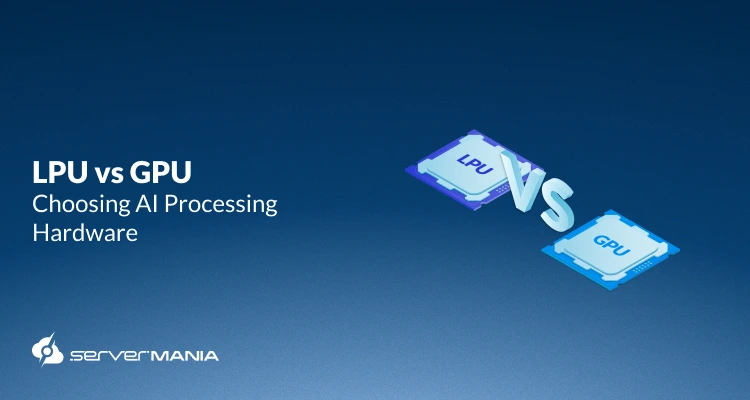
When you’re creating or growing AI infrastructure, you need to carefully consider your options when it comes to processing hardware.
For years, GPUs (Graphics Processing Units), or as techy people call them, “video cards”, have been the foundation for everything from deep learning to gaming. In 2025, LPUs, or Language Processing Units, are stepping into the spotlight for AI applications.
The key difference?
LPUs are built specifically for language tasks, while GPUs are for more general-purpose accelerators optimized for parallel data crunching. If your workload involves things like conversational AI, machine translation, or language modeling, this comparison could change your direction.
Here at ServerMania, we support AI teams and researchers with tailored infrastructure designed for high-performance computing. Our GPU server hosting and AI server guide are great starting points for building scalable, efficient AI environments.
But first, let’s break down LPUs vs GPUs, explore how they work, and what to choose for your next AI project.
What is LPU? (Language Processing Unit)
LPU (Language Processing Unit), is a processor that is specifically designed to boost “Natural Language Processing (NLP)”, required for AI tasks and workloads.
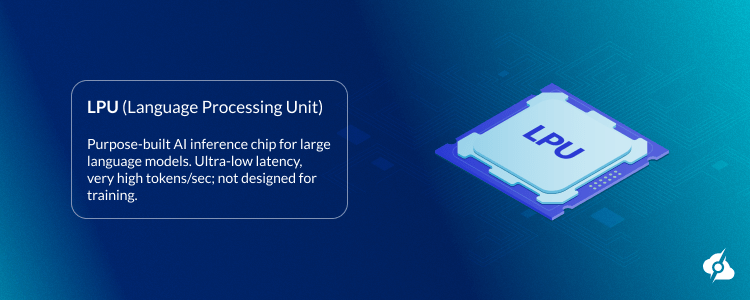
In contrast to the traditional CPUs (processors) or even many graphics cards (GPUs), the LPUs’ main purpose is to handle unique demands. Some of them include language translation services, sentiment analysis, speech recognition, and language processing tasks.
These tasks and workloads often involve sequential, memory-heavy operations that don’t scale across generic compute unit HW. LPUs tackle this by offering efficient processing of language data, thanks to custom-built processing elements, control logic, and streamlined data flow tailored for NLP workloads.
The strongest side of LPUs is the AI language applications that need real-time intervention, such as virtual assistants and human language generation. The LPUs are designed to strengthen the inference process by reducing lag and increasing throughput when handling pre-trained language models.
While LPUs are still dwarfs compared to giants in the industry like GPUs, they are quickly gaining traction as specialized hardware for teams looking to speed up deployment, reduce costs, and scale natural language systems more efficiently.
To understand LPUs better, let’s take a quick look at the strengths and weaknesses:
| Pros ✅ | Cons ❌ |
|---|---|
| Built specifically for language processing loads. | Not ideal for non-language AI tasks or general-purpose workloads. |
| Low latency and high throughput during inference tasks. | Still emerging and with lower software support than GPUs. |
| Optimized memory hierarchy and memory access. | May lack support and optimization for legacy learning libraries. |
| Superior for sequential processing of text-based input. | It can be more expensive than traditional processing unit alternatives. |
| Custom LPU inference engines for faster NLP tasks. | Limited availability in cloud providers and data centers. |
| Improved memory bandwidth for handling large datasets. | Less versatile, designed for very specific tasks and workloads. |
| Designed to generate human language with minimal latency. | Still early in adoption, while the community and tooling are still catching up. |
| Efficient at running tasks involving large language models. | Not widely benchmarked for video processing or image recognition. |
| Lower high power consumption compared to traditional accelerators. | Lack of graphics rendering and video editing support. |
| Excellent for AI processing that requires real-time responsiveness. | Limited ecosystem when directly compared to the GPUs. |
What is GPU? (Graphics Processing Unit)
GPU (Graphics Processing Unit)is a highly parallelized processor, designed with the main purpose of rendering graphics.
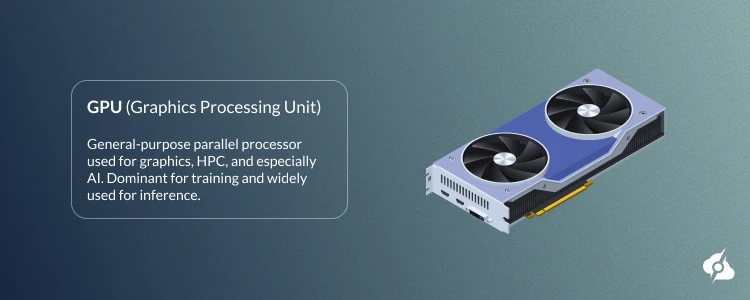
Due to its unique abilities, GPUs are now also used for complex AI workloads such as developing deep learning models, machine learning ML and neural networks.
While GPUs’ original purpose is graphics rendering, whether it’s gaming or video processing for export, their unique architecture allows them to run multiple threads in parallel.
This makes them ideal for tasks involving tensor operations, artificial intelligence workflows, scientific computing, image processing, and video editing.
At its core, GPUs are very versatile and provide extensive software support with many frameworks like PyTorch, CUDA, and TensorFlow. In addition, GPUs seem to be extremely scalable in environments like data centers, capable of processing data concurrently, often used in deploying deep learning models.
While not as specifically constructed as LPUs for language, their raw processing power and parallel processing capabilities still make them an essential tool in any serious AI development environment.
See Also: AMD vs NVIDIA GPU Comparison: Which is the Best GPU for You?
| ✅Pros | ❌Cons |
|---|---|
| Excellent at parallel processing across large datasets. | Less efficient for sequential processing and token-based language tasks. |
| Broader software supportacross major AI frameworks. | It can be overkill for smaller or more targeted AI applications. |
| Mature tooling and libraries like CUDA and cuDNN. | Higher power consumption, especially under higher loads. |
| Ideal for deep learning model training and experimentation. | Suboptimal latency for real-time complex tasks. |
| Strong at handling image recognition and video processing. | Not specialized for language processing workloads. |
| Available in most major cloud and AI infrastructure platforms. | Larger models may face memory bottlenecks compared to specialized LPUs |
| Proven performance in scientific computing. | May require cooling and power design adjustments in dense data centers. |
| Great for workloads involving large datasets. | Typically require driver/config updates more frequently than LPUs |
| Excellent scalability and processing power for training pipelines. | Can introduce latency in streaming NLP tasks and workflows. |
| Supports advanced data analytics and AI workloads. | Sometimes limited by internal memory hierarchy in larger models. |
LPU vs GPU: Key Differences
When you’re wondering about LPUs or GPUs for your AI tasks, you need to understand and carefully consider their differences. While both processing units are very powerful with their own strengths and weaknesses, they excel and shine in different AI workloads.
While LPUs specialize in language-related operations, GPUs excel at broad, high-throughput parallel processing.
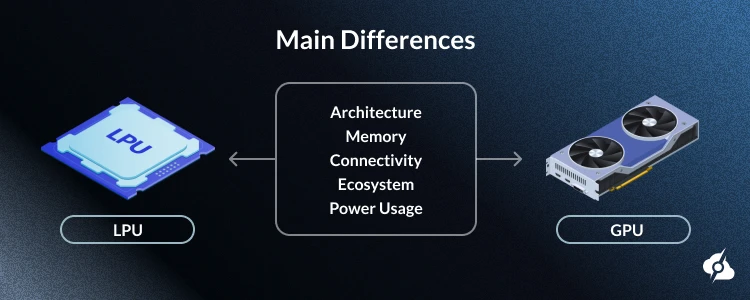
1. Architecture and Design
When we look at their architecture and design, LPUs are specifically designed to handle language processing projects, and their hardware is optimized for it.
This includes HW optimization for neural network layers, a memory system for human speech data, and attention mechanisms for real-time generation.
In contrast, GPUs were crafted for massive parallel processing with thousands of small cores working simultaneously. This makes them ideal for video rendering and large-scale numerical computations.
2. Memory and Management
An LPU’s architecture emphasizes on-chip memory and specialized storage to handle pre-trained models, embeddings, and sequence data efficiently. This focus supports the complex, sequential processing required by natural language.
GPUs rely on high-bandwidth memory like HBM or GDDR to manage vast datasets, 3D textures, and models, especially useful in training advanced learning networks and rendering tasks.
3. Transfer and Connectivity
Since the effectiveness of the communication between hardware components is critical for smooth operations, LPUs prioritize low-latency links.
In turn, while GPUs are generally faster, they use interconnect standards like PCIe and NVLink in order to process large volumes of data quickly, enabling seamless parallel computations.
4. Ecosystem & Compatibility
The LPUs ecosystem is still young and much narrower when compared with the GPU’s software base, but this is a subject for change in the future years. As for 2025, GPUs still benefit from a much more mature ecosystem with broader software support, with many compatible platforms and integration.
5. Power Usage & Resources
Because of the LPU’s targeted design, they often consume less power while maintaining high efficiency on language workloads. In turn, GPUs, with their general-purpose and parallel-heavy architecture, tend to have more power consumption, especially during intensive training loads or video rendering tasks.
LPU vs GPU: Use Cases
As mentioned, choosing the right hardware for your AI workloads really comes down to the specialized demands of your operations. While both the GPUs and LPUs have advantages, you need to explore their unique use cases, compare them with your intentions, and make a good choice.
When To Consider LPUs
As we now know, the LPU is made solely for NLP tasks, and its biggest advantage comes in human voice generation. Here are some scenarios where LPUs offer better and clearer advantages that can significantly improve performance:
- Handling large language models and pre-trained models for applications like speech translation services and machine translation.
- Running inference tasks involving sequential processing of text, such as voice recognition or sentiment analysis.
- Powering virtual assistants that rely on real-time natural language processing (NLP) to understand and generate human responses.
- Managing language data workflows that demand low latency and efficient memory access for quick response times.
- Optimizing AI language applications where precise and contextual text understanding is critical and vital for your workload.
When to Choose GPUs
While LPUs are better in language generation, GPUs remain the best solution for many other AI loads, with a broader scope in today’s AI and ML. Their parallel processing advantages make them perfect for large volumes of data and complex tasks, including:
- Training and deploying deep learning apps in industry fields like image recognition and frame processing, and even gaming.
- Running machine learning tasks that involve processing huge datasets, such as in data analysis, when data must be processed concurrently.
- Performing video rendering and other high-performance parallel processing tasks in gaming, virtual reality, or 3D modeling.
- Managing operations and workflows requiring extensive data bandwidth and throughput across the environment.
- Executing AI workloads that demand flexible, multipurpose hardware able to switch between multiple threads and task types efficiently.
If you recognize your workload here, then we’ve made it clear. GPU or LPU depends on what you’re doing and how you’re doing it.
LPU Vs GPU: Technical Comparison
When you are selecting the right hardware for high-performance AI systems, surface-level specs won’t provide enough insights. You need to understand how these processors behave under real-world artificial intelligence workloads, especially in a growing environment.
In this section, we’ll compare an LPU built on Groq’s Tensor Streaming Processor (TSP) architecture and a GPU, specifically NVIDIA’s high-end H100, to give you a clearer picture of their design logic, runtime behavior, and operational efficiency.
| LPU (Groq TSP) | GPU (NVIDIA H100) | |
| Architecture | Sequential, Deterministic | Parallel, Non-deterministic |
| Best For | LLM Inference | Training & Inference |
| Memory Type | On-chip SRAM | HBM3 |
| Power Efficiency | ~1W per token/s | ~5-10W per token/s |
| Latency | Deterministic, <100ms | Variable, 200-1000ms |
| Software Ecosystem | Emerging | Mature (CUDA) |
| Cost per Token | Lower for inference | Higher but versatile |
Memory and Latency Explained
LPUs use a tenor-streaming design tuned for natural language tasks. Their network-on-chip keeps internal communication quick, which makes execution predictable and latency low. They also tend to use less energy per token, so language-heavy workloads can scale cost-effectively.
GPUs group thousands of processing cores into large computer clusters to deliver broad parallel performance. They offer wide compatibility and excel at images, simulations, and other dense compute jobs. Their global memory increases capacity but can add latency for sequential or text-heavy workloads
In short, LPUs are specialized for language processing where milliseconds and efficiency matter most. GPUs remain the versatile choice for general AI and high-throughput compute.
See Also: GPU Temperature Range: Complete Guide to Optimal GPU Temperatures in 2025
ServerMania’s AI Infrastructure Solutions
When it comes to deploying high-performance AI workloads, infrastructure matters.
At ServerMania, we provide tailored solutions built to support everything from large language models to data analytics, with the flexibility and scale modern teams need.
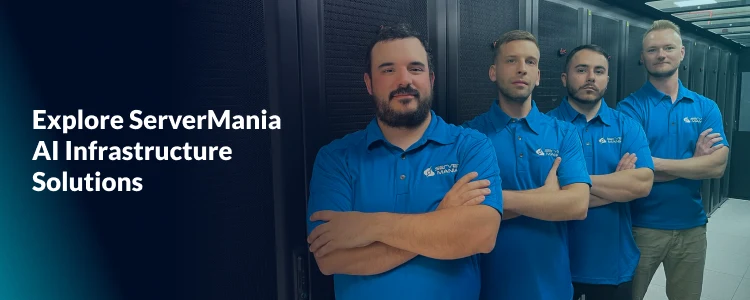
Our GPU server hosting is engineered for speed and reliability, backed by high-bandwidth connectivity and enterprise-grade hardware. For teams focused on AI, our dedicated AI server guide offers expert advice on selecting and configuring servers for machine learning tasks and inference processes.
We also offer unmetered dedicated servers that support round-the-clock performance for demanding AI workloads. So, whether you’re building a new AI product or scaling enterprise research, ServerMania delivers the optimized performance and support needed to move fast, without compromise.
💬 Need help choosing the right AI hardware? Talk to a ServerMania expert today and get personal guidance for your next big AI project. Contact us now.
Was this page helpful?

